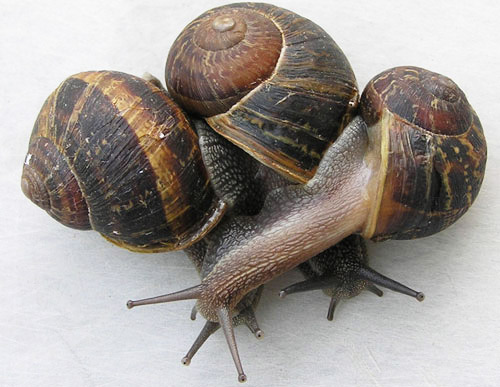

Photograph: EzumeImages/Getty Images/iStockphoto Headlam tends to put them in the bin or takes them to the park.Ĭaught in the act … a common garden slug. The question then is what to do with them.
Garden snail tv#
The garden designer and TV presenter Flo Headlam calls it going on “an evening patrol, particularly after it’s rained”. The best way to ensure you find the guilty ones is to catch them in the act. They’re also the ones that you find inside the heads of your lettuce.” If you go rummaging around in the leaf litter or underneath plants that have got holes in them, you’ll probably find them. They’re a grey beige colour, with darker speckles over the skin.

“They are about 4cm when they’re fully grown but for a lot of the year, they’re way smaller than that. Jones says the common garden snail – the one with the brown shell – is probably the most pernicious of snails, and the main slug to watch out for is the netted field species. “People often measure success by the number of dead bodies and that’s not necessarily very informative,” says Jones of methods such as the beer trap – a sunken bowl of beer, which attracts and drowns slugs: “There is quite a lot of science being done on bait in terms of beer and yeast, but they only really measure how many slugs you catch, rather than how undamaged the plants were as a result.” If you use pellets or traps you can indiscriminately kill creatures that wouldn’t have bothered your darling dahlias in the first place. “It doesn’t actually eat other slugs, but it will attack them for encroaching on its territory.” It may therefore actually help to protect your plants by acting as a guard slug. “The leopard slug is very territorial, which is where its reputation for being a cannibal comes from,” says Jones. Curious sex life aside, leopard slugs – they are brown or grey with dark spots – prefer to eat fungi and rotting matter, and are a good thing to have in your garden. A whole load of TikTok users got very excited earlier this year when one posted a video of two leopard slugs mating – sexily, it involves hanging upside down by a string of mucus and entwining their giant blue penises (slugs are hermaphrodites, having male and female sex organs), which emerge from their heads. They come in different patterns and colours, have thousands of teeth and their slime is a non-Newtonian fluid (its viscosity changes under pressure), which has been researched for medical uses, such as surgical glue. Photograph: Ewa Saks/Getty Images/iStockphoto On guard … the leopard slug is very territorial, which may actually help to protect your plants. But what is clear is that for most gardeners doing nothing is not an option: in its annual pest ranking, the Royal Horticultural Society (RHS) found that slugs and snails were again gardeners’ biggest foe, after sliding down the chart in recent years. Less extreme options include gently relocating them, or surrounding their victims with protective barriers.

It is tempting to view gastropods as the enemy, and to start a war that can include search and destroy techniques alongside biological weapons and traps. “You suddenly see these swarms of slugs everywhere.” “It’s quite shocking what you find sometimes,” says Charles Dowding, an organic gardener and author. Go out at dusk with a torch, particularly if it has been raining. It’s not that there are more than usual this year – experts don’t think that’s the case – but after a cold and dry April, perhaps the ones that are emerging are doing so with a vengeance and heading for the hostas. In the past few weeks, the slugs and snails have risen – and they are hungry. I f there is anything likely to send even the most mild-mannered gardener on a murderous rampage, it is waking one morning to find the lettuce has been shredded and the carefully nurtured young plants have been razed overnight.


 0 kommentar(er)
0 kommentar(er)
